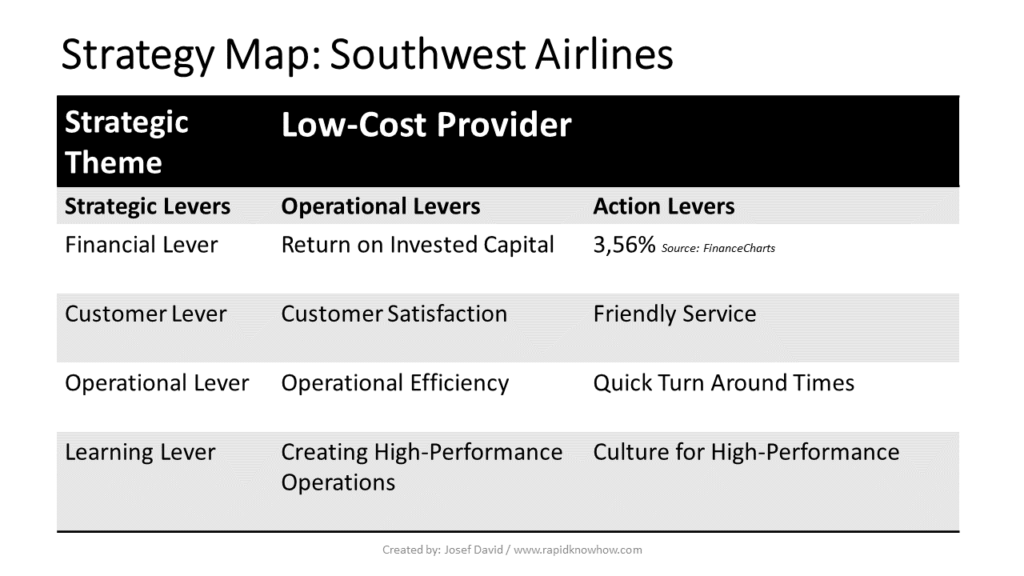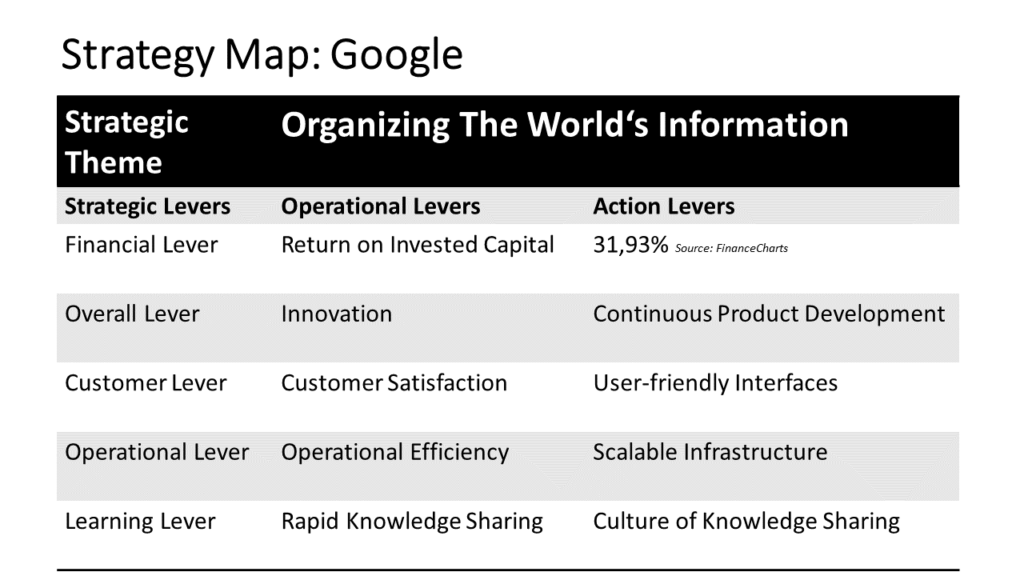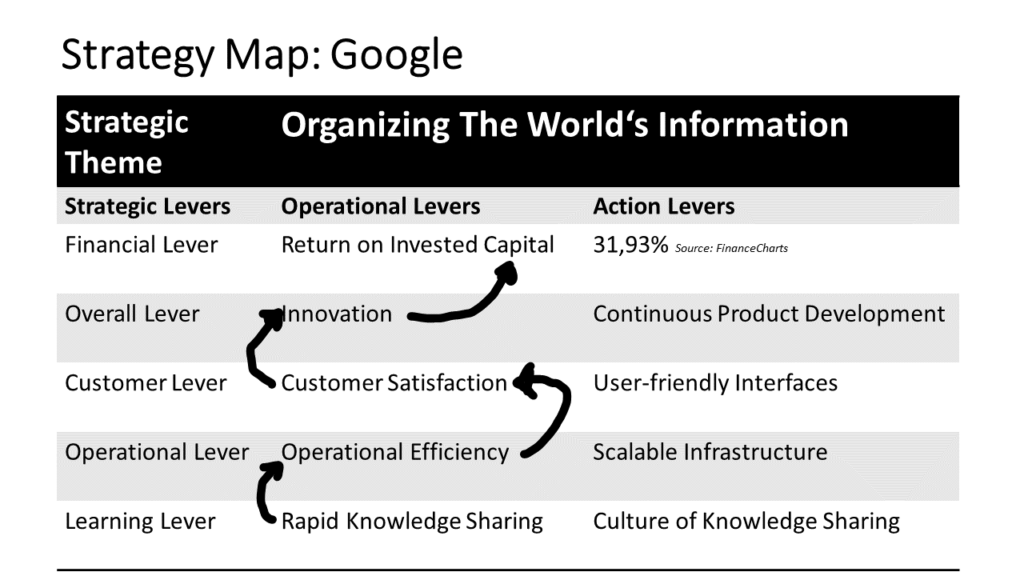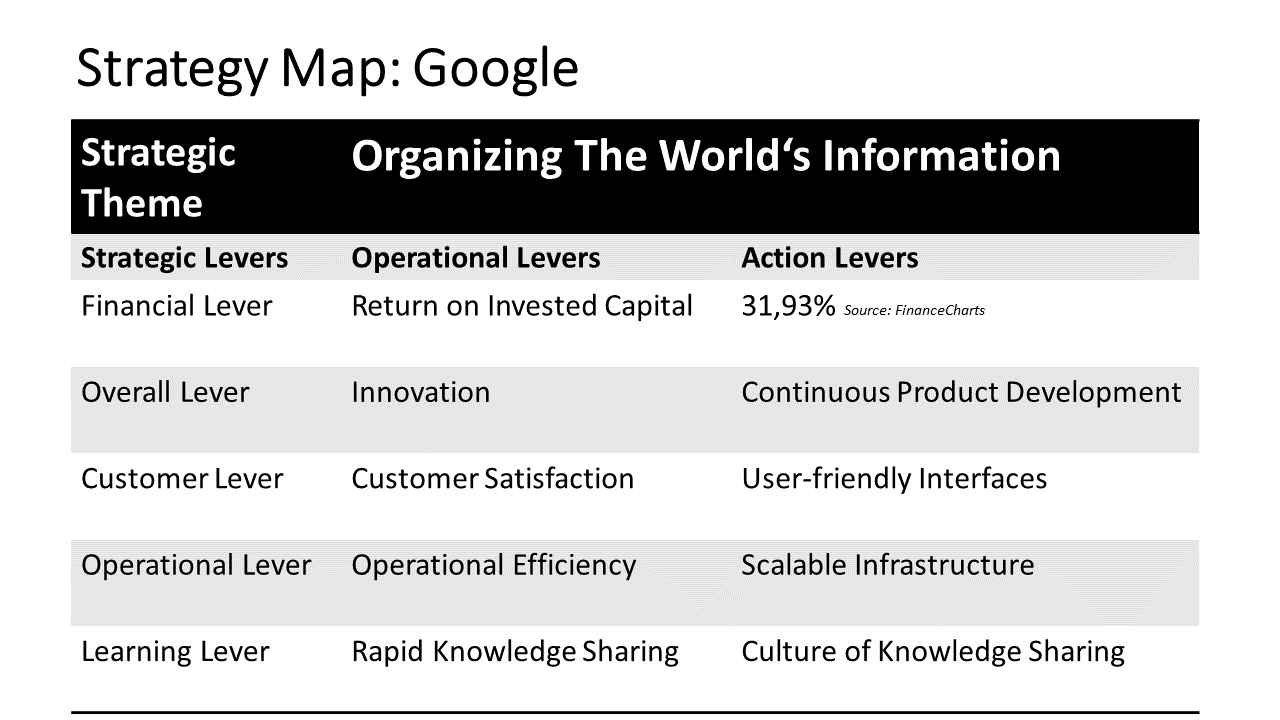Cracking the Strategic Mapping Code
Strategic mapping is a powerful tool that businesses use to visualize their strategies and align their operations with their goals. It’s a comprehensive approach that allows organizations to clearly define their strategic theme, determine their strategic levers, and then implement these strategies effectively. Let’s delve deeper into this topic.
Firstly, it’s crucial to define your strategic theme.
This is essentially the overarching objective or goal that your organization aims to achieve.
It could be anything from
increasing market share,
improving customer satisfaction,
enhancing operational efficiency, or
fostering innovation.
The strategic theme serves as the guiding light for all your business activities and decisions. It provides a clear direction and helps ensure that all your efforts are aligned towards achieving this common goal.
Once you’ve defined your strategic theme,
the next step is to determine your strategic levers for this theme. These are the key areas or aspects that you need to focus on in order to achieve your strategic theme. There are typically four main types of strategic levers: financial, customer, operations, and learning.
The financial lever involves all aspects related to your organization’s financial performance such as revenue growth, cost reduction, profitability improvement etc.
The customer lever focuses on enhancing customer satisfaction and loyalty through improved product quality, better customer service etc.
The operations lever deals with improving operational efficiency and effectiveness through process optimization, technology adoption etc.
Lastly, the learning lever involves fostering a culture of continuous learning and development within the organization to enhance its capabilities and competitiveness.
Case Studies
There are numerous case studies of successful companies using strategy maps effectively.
For instance, Southwest Airlines has used strategy maps to clearly define its strategic theme of ‘low-cost provider’ and then identified key strategic levers such as operational efficiency (through quick turnaround times), customer satisfaction (through friendly service), and financial performance (through low fares). This has helped Southwest become one of the most successful airlines in the world.

Similarly, Google has used strategy maps to align its operations with its strategic theme of ‘organizing the world’s information’. It has focused on strategic levers like innovation (through continuous product development), customer satisfaction (through user-friendly interfaces), operational efficiency (through scalable infrastructure), and learning (through a culture of knowledge sharing).

To get started using your strategy map, begin by defining your strategic theme clearly. Then identify the key strategic levers that you need to focus on in order to achieve this theme. Once you’ve done this, develop specific strategies for each lever and align your resources accordingly. Regularly review and update your strategy map based on changes in your business environment or performance.
In conclusion, cracking the strategic mapping code involves a clear understanding of your organization’s goals (strategic theme), identifying key areas of focus (strategic levers), developing effective strategies for these areas, and then implementing these strategies effectively through alignment of resources and regular review. By doing so, you can significantly enhance your organization’s performance and competitiveness.
Getting Buy-in for Your Strategy Maps in 6-Steps
Creating Strategy Maps Fast: A Comprehensive Guide
Strategy maps are a visual representation of an organization’s strategic goals. The actions to achieve them, are a crucial part of the Balanced Scorecard methodology, a strategic planning and management system that aligns business activities with the vision and strategy of the organization.
Getting buy-in for your strategy maps can seem like a daunting task, but with a clear understanding of your strategic objectives and a systematic approach, you can create them quickly and efficiently. Here’s a step-by-step guide on how to do it.
1. **Identify Strategic Themes**
The first step in creating a strategy map is to identify your strategic themes. These are the broad areas that your strategy needs to address. They provide a framework for your strategy map and help you focus on what’s important.
Some common strategic themes include:
increasing return on invested capital, increasing market share, improving customer satisfaction, enhancing operations efficiency, and fostering innovation. These themes represent different aspects of your business that you want to improve or grow.
2. **Define Objectives for Each Theme**
Once you’ve identified your strategic themes, the next step is to define specific objectives for each theme. These objectives should be SMART (Specific, Measurable, Achievable, Relevant, Time-bound). For example, if one of your themes is “Increasing Market Share,” an objective might be “Increase market share by 10% in the next 12 months.”
3. **Map Out Cause-and-Effect Relationships**
After defining your objectives, you need to map out the cause-and-effect relationships between them. This is where you show how achieving one objective will lead to the achievement of others.
For example, improving customer satisfaction (cause) might lead to increased market share (effect) because satisfied customers are more likely to recommend your products or services to others.
4. **Identify Key Performance Indicators (KPIs)**
KPIs are metrics that help you measure progress towards your objectives. For each objective on your strategy map, identify at least one KPI.
For example, if one of your objectives is “Enhance Operations Efficiency,” a possible KPI could be “Reduce production costs by 15%.”
5. **Assign Ownership**
Each objective on your strategy map should have an owner – someone who is responsible for ensuring that the objective is met. This helps ensure accountability and focus.
6. **Communicate Your Strategy Map **
Once you’ve created your strategy map, it’s important to communicate it to everyone in your organization. This helps ensure alignment and buy-in from all stakeholders.
Remember that creating a strategy map is not a one-time activity; it’s an ongoing process that should be reviewed and updated regularly as your business environment changes.
Building and Communicating the Result of the Strategy Map
The strategy mapping demonstrates how cause and effect work, thereby achieve the strategic theme or goal.
Let‘s take the Google example: Google has a Culture of Knowledge Sharing which leverages the knowledge across the whole organization fast.
By building a scalable infrastrastructure, Google builds an efficient and effective global operational network.
Google‘s web-page is user-friendly and helps the seeker to get result rapidly.
Google builds on it‘s huge and growing database and know-how of it‘s providers and seekers and innovates continuously it‘s search engine.
That‘s why Google generates an impressive Return on Invested Capital of 31,93%

In conclusion, creating strategy maps fast involves identifying strategic themes, defining SMART objectives for each theme, mapping out cause-and-effect relationships between objectives, identifying KPIs for each objective, assigning ownership for each objective and communicating the completed map throughout the organization.
By following these steps systematically and diligently, you can create effective strategy maps quickly and efficiently – thereby enabling better strategic planning and execution in your organization.
